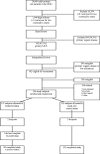Primary care clinicians treat patients with medically unexplained symptoms: a randomized controlled trial
- PMID: 16808764
- PMCID: PMC1924714
- DOI: 10.1111/j.1525-1497.2006.00460.x
Primary care clinicians treat patients with medically unexplained symptoms: a randomized controlled trial
Abstract
Objective: There is no proven primary care treatment for patients with medically unexplained symptoms (MUS). We hypothesized that a long-term, multidimensional intervention by primary care providers would improve MUS patients' mental health.
Design: Clinical trial.
Setting: HMO in Lansing, MI.
Participants: Patients from 18 to 65 years old with 2 consecutive years of high utilization were identified as having MUS by a reliable chart rating procedure; 206 subjects were randomized and 200 completed the study.
Intervention: From May 2000 to January 2003, 4 primary care clinicians deployed a 12-month intervention consisting of cognitive-behavioral, pharmacological, and other treatment modalities. A behaviorally defined patient-centered method was used by clinicians to facilitate this treatment and the provider-patient relationship.
Main outcome measure: The primary endpoint was an improvement from baseline to 12 months of 4 or more points on the Mental Component Summary of the SF-36.
Results: Two hundred patients averaged 13.6 visits for the year preceding study. The average age was 47.7 years and 79.1% were females. Using intent to treat, 48 treatment and 34 control patients improved (odds ratio [OR]=1.92, 95% confidence interval [CI]: 1.08 to 3.40; P=.02). The relative benefit (relative "risk" for improving) was 1.47 (CI: 1.05 to 2.07), and the number needed to treat was 6.4 (95% CI: 0.89 to 11.89). The following baseline measures predicted improvement: severe mental dysfunction (P<.001), severe body pain (P=.039), nonsevere physical dysfunction (P=.003), and at least 16 years of education (P=.022); c-statistic=0.75.
Conclusion: The first multidimensional intervention by primary care clinicians led to clinically significant improvement in MUS patients.
Figures
Similar articles
-
The mental health patient profile: does it change primary care physicians' practice patterns?J Am Board Fam Pract. 1996 Sep-Oct;9(5):336-45. J Am Board Fam Pract. 1996. PMID: 8884672 Clinical Trial.
-
The outcomes among patients presenting in primary care with a physical symptom at 5 years.J Gen Intern Med. 2005 Nov;20(11):1032-7. doi: 10.1111/j.1525-1497.2005.0241.x. J Gen Intern Med. 2005. PMID: 16307629 Free PMC article.
-
Are medically unexplained symptoms and functional disorders predictive for the illness course? A two-year follow-up on patients' health and health care utilisation.J Psychosom Res. 2011 Jul;71(1):38-44. doi: 10.1016/j.jpsychores.2011.02.015. Epub 2011 Apr 22. J Psychosom Res. 2011. PMID: 21665011 Clinical Trial.
-
Mindfulness and bodily distress.Dan Med J. 2012 Nov;59(11):B4547. Dan Med J. 2012. PMID: 23171754 Review.
-
Behavioral disorders: an unrecognized epidemic with implications for providers.HMO Pract. 1995 Jun;9(2):53-6. HMO Pract. 1995. PMID: 10143151 Review.
Cited by
-
Experience of being a frequent user of primary care and emergency department services: a qualitative systematic review and thematic synthesis.BMJ Open. 2020 Sep 9;10(9):e033351. doi: 10.1136/bmjopen-2019-033351. BMJ Open. 2020. PMID: 32912938 Free PMC article.
-
Cognitive behaviour therapy for long-term frequent attenders in primary care: a feasibility case series and treatment development study.Br J Gen Pract. 2016 Oct;66(651):e729-36. doi: 10.3399/bjgp16X686569. Epub 2016 Jul 18. Br J Gen Pract. 2016. PMID: 27432609 Free PMC article.
-
Acupuncture for 'frequent attenders' with medically unexplained symptoms: a randomised controlled trial (CACTUS study).Br J Gen Pract. 2011 Jun;61(587):e295-305. doi: 10.3399/bjgp11X572689. Br J Gen Pract. 2011. PMID: 21801508 Free PMC article. Clinical Trial.
-
Making sense of symptoms, clinicians and systems: a qualitative evaluation of a facilitated support group for patients with medically unexplained symptoms.BMC Fam Pract. 2021 Jul 1;22(1):142. doi: 10.1186/s12875-021-01495-9. BMC Fam Pract. 2021. PMID: 34210272 Free PMC article.
-
Cost-effectiveness of nurse practitioners in primary and specialised ambulatory care: systematic review.BMJ Open. 2015 Jun 8;5(6):e007167. doi: 10.1136/bmjopen-2014-007167. BMJ Open. 2015. PMID: 26056121 Free PMC article.
References
-
- deGruy F, Columbia L, Dickinson P. Somatization disorder in a family practice. J Fam Pract. 1987;25:45–51. - PubMed
-
- 4. Washington, DC: American Psychiatric Association; 1994. American Psychiatric Association: Diagnostic and Statistical Manual of Mental Disorders.
-
- Escobar JI, Waitzkin H, Silver RC, Gara M, Holman A. Abridged somatization: a study in primary care. Psychosom Med. 1998;60:466–72. - PubMed
-
- Bridges KW, Goldberg DP. Somatic presentation of DSM III psychiatric disorders in primary care. J Psychosom Res. 1985;29:563–9. - PubMed
Publication types
MeSH terms
Grants and funding
LinkOut - more resources
Full Text Sources
Medical

